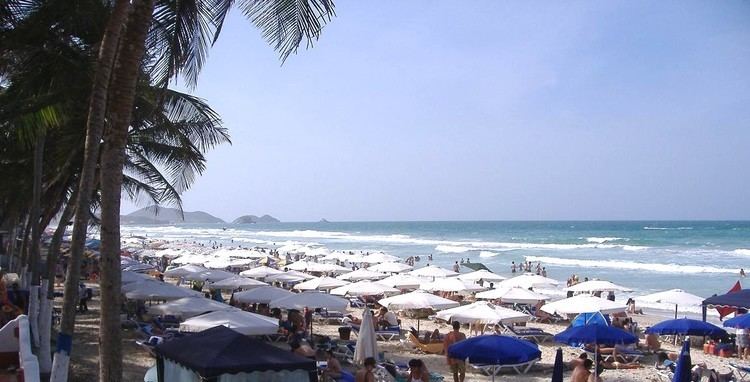 | ||
Tourism in Venezuela has been developed considerably in recent decades, particularly because of its favorable geographical position, the variety of landscapes, the richness of plant and wildlife, the artistic expressions and the privileged tropical climate of the country, which affords each region (especially the beaches) throughout the year.
Contents
Mérida
Mérida state, for the beauty of its mountain scenery and pleasant climate, is a major tourist center in Venezuela. It has an extensive network of hotels not only in the capital city but also throughout the state. Starting from the city of Mérida, it is the longest and highest cable car in the world, reaching the Espejo Peak of 4,765 m. It is also necessary to recommend to cover on magnificent roads, Méridan páramos, where there are good hotels and restaurants. In Ejido it have to visit the Venezuela of Before and in Mucuchíes, the village of Los Aleros. Both this, as above, have been created to show how lived in a Venezuela that it went. Also it can go to visit the National Observatory of Llano del Hato. The city has several museums worth visiting: Beekeeping Museum, Colonial Art Museum, Modern Art Museum, and the Museum of the great Méridan Don Mariano Picón Salas and the Aquarium Garden. Also in the state there are hot springs and between them it have to mention the of Bailadores Las Tapias and la Capellanía Park.
Margarita Island
Margarita is one of the top tourist destinations for enjoyment and relaxation. It is an island with a modern infrastructure, bordered by beautiful beaches suitable for extreme sports, and features castles, fortresses and churches of great cultural value.
Caracas
Caracas is the capital of Venezuela, is a world-class cosmopolitan city. In the west of the city, the Libertador municipality, tourism is important in regard to the historic center of the city, the Caracas Cable Car (Ávila mountain Cable Car), the University City of Caracas, Zoos, Sabana Grande Boulevard, among others.
In the east of the city, especially in the Chacao and Baruta municipalities environment of progress and modernism is indisputable, European-style shopping malls, beautiful squares, night clubs, etc. Also the Generalísimo Francisco de Miranda Park, located in the Sucre municipality is heavily of exploitation for tourism.
In the southeast end of city is located a small town, El Hatillo, which has an impeccable colonial town, an atmosphere of peace and tranquility.
To further exploitation of tourism as a factor of endogenous development, the national government has created socio-cultural plans of international concern as the Feria Internacional de Turismo de Caracas (FITCAR), which has been carried held annually since 2005 and promotes tourism in the country, showing to the world the cultural, tourist, traditional, musical and culinary wonders of Venezuela.
Caracas is one of the most dangerous cities in the world, with extremely high rates of murder, street robbery and kidnapping. The police is very corrupt and often collaborate with the criminal gangs.
Los Roques and Morrocoy
The archipelago of Los Roques is formed by a group of islands and cays that make up one of the main tourist attractions of the country. With exotic pristine beaches. Morrocoy is a park, consisting of very small nearby islands to the mainland, which have grown rapidly as one of the biggest tourist attractions in the Caribbean.
Canaima
Canaima National Park is spread over 30,000 square kilometers to the border with Guayana Esequiba reclamation area now Guyana and Brazil, for its size is considered the world's sixth largest national park. About 65% of the park is occupied by rock plateaus called tepuis. These are a unique biological environment, also presenting a great geological interest. Its steep cliffs and waterfalls (including Angel Falls, which is the highest waterfall of the world, 1,002 m) are spectacular sceneries.
World Heritage
Beaches
Venezuela has many beaches of calm waters and for extreme sports. Besides those already mentioned, most famous sites for its beauty its are:
Jungle and Savannah
South of Venezuela in the states Bolivar, Amazonas and Delta Amacuro begins the Amazon rainforest, the largest rainforest and the largest nature reserve in the world. This area of the country has great tourism value, because there is the Angel Falls, the highest waterfall of the world; savannah, rivers, forests and tepuis form a ecotourism that has not yet been truly exploited, it is necessary that the national government to promote plans to turn over this Venezuelan soil an essential point for ecotourism in this part of the world.
However, the influx of international tourists in Canaima and the Gran Sabana is high and has been gradually growing, some attractions in forest and savanna in Venezuela are:
Mountain
Although Venezuela is dominated by plains and tropical temperatures, it also has a mountain range of great tourist attraction, In Venezuela begins the Andes, Mérida state consists mainly of páramo vegetation, low temperatures, snow filled peaks, glaciers and high mountains of the Venezuelan Andes. Some of the Venezuelan mountain attractions are:
Los Llanos
Los Llanos is the region of Venezuela, plains with few elevations, dominated by plateaus, hills, lakes and pastures, the climate is warm and has an average tourist reception, but it is an important site for the rural vacation, covering most of the states Apure, Barinas, Cojedes, Portuguesa, Guárico, Anzoátegui, Monagas and Delta Amacuro. In these rural plains are combined flora, fauna, livestock culture and typical of the autochthonous culture of Venezuela. The higher mountain elevations of this Venezuelan region are in San Juan de los Morros.
Others
Cities
Towns
Moreover, there is a foreign exchange market called "parallel market" or "black market" the prices of the dollar in this market can be up to 15 times the established by the executive 6.30 bolívares fuertes for 1 dollar.
